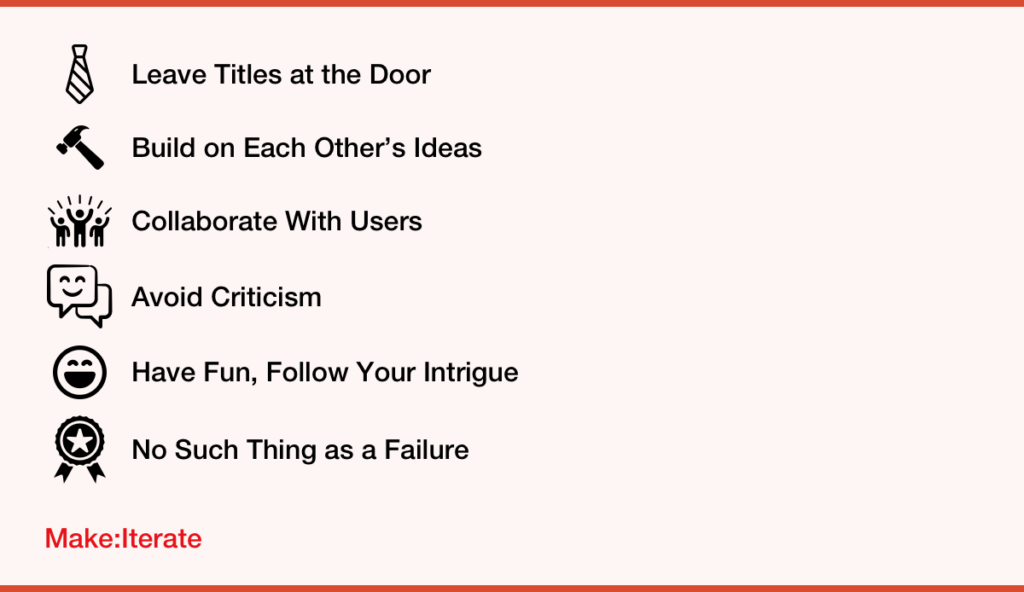This article will explore how to use the Stanford Design Thinking process to solve complex problems with creative solutions.
Did you know?
To help teams implement Design Thinking, we offer bespoke innovation training workshops. Talk with us and find out how we can help transform the way you design your products and services.
Interested? Message us in the bottom right corner or learn more here.

What Is the Stanford Design Thinking Process?
Stanford Design Thinking has become a powerful tool for businesses and organizations to solve complex problems with creative solutions.
The process helps us to understand people’s needs, empathize with their experience, reframe the challenge and generate out-of-the-box solutions.
It involves understanding people’s needs, empathizing with their experience, reframing the challenge to generate out-of-the-box solutions, prototyping and continuously refining ideas, and testing these prototypes with real users to create successful products.
In this way, Stanford Design Thinking encourages teams to put the user first while fostering creativity in exploring possible solutions. This winning combination makes it one of the most valuable problem-solving methods available today.
The 5 Steps of the Stanford Design Thinking Process
Empathize: Understand User Needs
A human-centered design process isn’t just about creating for people in mind; it understands the way they think and why. It requires us to really put ourselves in their shoes: what do physical and emotional needs look like? What makes something meaningful to them? These steps are part of an empathize mode—the heart of any successful project!
For design thinkers, understanding people is critical for success. Observing and recognizing what drives them provides invaluable insight that can be used to craft cutting-edge solutions. The ability to see through someone else’s eyes reveals a world of possibilities – an essential ingredient in creating something unique.
To gain deeper insights into user behavior, take the time to observe them in their proper environment and have an open dialogue about what they think. Dig deeper with questions while watching people interact with products – let users vocalize their thoughts so that you can truly comprehend how they feel and why.
Define: Define The Problem
The define phase is where we decide where to focus and where to go.
To discover insights that really make an impact, we need to take time for synthesis so we can recognize correlations & patterns.
One of the key outputs of this phase is a meaningful and actionable problem statement. The define phase makes this process easier by helping us identify a meaningful, actionable problem statement – or what Stanford Design School refers to as “the point-of-view.”
The Define phase is a crucial stage in the design process. It helps you identify your point of view and determine the proper challenge to tackle based on newfound perspectives of people and their issues. By taking time to synthesize research findings into meaningful insights, this step sets up a fantastic opportunity for truly innovative solutions.
Uncover the hidden stories lurking in your user research. Deep dive into findings and notes taken during the empathize phase – explore any striking or unexpected patterns, themes, and insights.
This rigorous review can be a great design team activity that helps set you up for success later on, with actionable problem statements to fuel innovation. With curiosity at its helm, investigate what’s most interesting, then have an eye-opening conversation about how best to proceed as one unit.
Ideate: Generate Solutions
The Ideation phase is the gateway to innovation. It offers creatives an opportunity to take all of their research and understanding about a problem space and couple it with imagination to craft solutions that users need.
It’s not just about coming up with one correct answer—it’s also exploring possibilities by “going wide” so you can choose from many viable pathways as your journey progresses.
Ideation allows the Design Thinker to go beyond the obvious solutions to discover creative possibilities to unlock the most customer value.
During ideation, we experiment with creative techniques to create new pathways to innovative ideas. We play with the constraints, reframe the challenge, reserve judgment, and build on each other’s ideas. A few popular methods for ideating are Crazy 8’s, Round Robin, and Mind Mapping.
Over time as you become more experienced, you can start to mix and match techniques to push the boundaries of your team’s creativity.
Prototype: Make Your New Idea Tangible
In the Prototype phase, ideas become tangible. Instead of just being an idea in your head, it’s time to get creative and build something that people can interact with.
Be it a sketch of your idea or a clickable prototype – so you can quickly gather valuable feedback from users and stakeholders alike.
The first version of the prototype should be quick and dirty – just enough to get the feedback you need – this way, it’ll be easier to iterate, refine, discard or pivot depending on the reaction of your end users.
Each iteration of your prototype can increase in quality as you gain confidence in your decisions based on the reliable evidence you’re gathering.
This way, each conversation is tailored to glean insights into how they interact with your product—discovering precisely what works and what could be improved.
Test: Get Feedback From Users
The testing phase is an invaluable opportunity to gain insight into who we’re designing for and better understand the problem.
It’s where we validate the decisions made throughout the rest of the process and gain a depth of insight that allows us to determine whether our design will likely create meaningful customer value.
As we test our prototype, we’re not only validating whether or not the customer likes what we’ve made. We’re using the prototype to better understand the customer’s needs and motivations.
We want to dig deep to find out why they have the reaction they do so that we can continue to develop our understanding of the problem and what’s needed from the potential solution.
The best way to test your prototype is to put it into users’ hands and give them some tasks to complete or discuss.
By observing the customer’s reactions, we look for cues that might signal a more profound need or expectation. We then probe deeper into these notable reactions to get the insights needed to craft something innovative.

The 6 Design Thinking Principles
- Leave titles at the door: The Design Thinking methodology relies on collaboration and opens honest communication. Everyone in the room needs to feel safe and that their thoughts are valued.
- Build on each other’s ideas: Each thought or view expressed is a new platform to launch from. Creativity is all about finding and connecting the dots. Do this by building on each other’s thoughts.
- Collaborate with users: Bring the people you’re designing for into the design process. Keep them involved at key milestones to ensure that your process is human centered design.
- Avoid criticism: Criticism is often either destructive or limiting. The creative process involves expansive thought, empowering each other, and sharing the same goals.
- Have fun, follow your intrigue: We’re most creative and productive when we’re having fun. When you feel good, you’ll go further, dig deeper, and persist in overcoming challenges.
- No such thing as a failure: There really isn’t. Take the word out of your vocabulary. Each attempt is another step forward. There is nothing more to it.
What Types of Problems Can the Process Solve?
Design Thinking is particularly effective at solving complex or ill-defined problems that relate to humans’ complex and varied needs.
This is because design thinking looks at a problem from many angles, forces us to challenge assumptions, and includes various stakeholder groups in the process.
These types of problems are referred to as Wicked Problems. A wicked problem is a complex conundrum that defies definition, offering no easy answer or a one-size-fits-all solution. It requires creativity and innovation to untangle its intricate web of complexities.
In contrast to a wicked problem, some issues can be resolved with the traditional analytical approach to problem solving.
For example, an issue within a manufacturing process can be clearly defined and solved objectively. An approach like Six Sigma might be more suitable for this problem.
Design thinking is the perfect tool for tackling tough challenges where solutions aren’t obvious, variables are fluid, and unpredictable human factors can make all the difference.
The more we practice Design Thinking, the greater our creative confidence becomes and the better we’ll be at creative problem solving.
How to Get Started Using the Process
If you’re interested in getting started with the Stanford Design School’s design thinking process, it’s vital to get buy-in from your organization.
Having stakeholders on board to support your project is critical for success.
Outline what need you’re trying to solve, who will be impacted most (including stakeholders), and potential success measures that can track your progress.
Finally, remember that everyone involved should have an active role in shaping the innovation. When all parties are engaged during each stage of the design process—ideation, prototyping, and testing—they will be more likely invested in its outcome.

An Example of Design Thinking Success
The Background: IDEO partnered on a social innovation with a diverse group of individuals, designers, businesses, and foundations to tackle the global challenge of food waste. In response, they designed an array of cutting-edge innovations that aim to reduce 1.3 billion tons annually, revolutionizing how people, companies, and governments interact with food resources to leave our planet better than before.
The Method: IDEO utilized a participatory design method to develop innovative solutions for the global food waste crisis. They collaborated with environmental groups representing various facets of this dilemma, igniting an Open Innovation Practice that drew participants from 113 countries. After reviewing over 20,000 entries proposing 450 different ideas – 12 suggestions emerged as potential game-changers in tackling our planet’s rampant unwanted edibles issue.
The Outcome: One innovation was to create software that allows communities to collectively purchase food directly from wholesalers and a service that takes excess meals from corporate events to people in need. A $50,000 grant was given to a scale-up that has a creative innovation that converts inedible food and paper waste into a compostable alternative to oil-based plastic. The initiative brought communities together, inspired them, and armed them with the tools they needed to consciously reduce their waste as individuals. And the initiative helped secure funding for a range of startups experimenting in the area of food waste reduction and sustainability. The power of participatory design thinking workshops is quite amazing.
Different Design Thinking Models
“Design thinking is not limited to a process. It’s an endlessly expanding investigation.”
Sandy Speicher, IDEO CEO.

Double Diamond
The Double Diamond is a Design Thinking framework designed by the British Design Council. It was created by interviewing several leading design authorities about their processes.
Similar to the Stanford Design Thinking process, its steps are:
- Discover
- Define
- Develop
- Delivery
It’s an incredibly effective framework for navigating ambiguous or complex design challenges. One fundamental tenet is the idea of diverging and converging thought, where we go through a process of going wide to explore before going narrow to define.
IDEO Design Thinking Process
IDEO – an agency co-founded by Stanford Professor David Kelley along with Tom Kelley – are well-respected Design Thinking practitioners that publishes ideas, tools, and techniques through IDEO U to help others learn and practice the process effectively.
They emphasize that the design thinking approach isn’t linear; its fluid. And although we depict the steps of the process in a linear sequence, in reality, we might go back and forth as we gather learnings throughout the process.
IDEO’s Design Thinking Process is as follows:
- Frame a Question
- Gather Inspiration
- Generate Ideas
- Make Ideas Tangible
- Test to Learn
- Share the Story
Design thinking can unleash a whirlwind of creativity, taking you on an ever-evolving journey to the cutting edge. Through iterative cycles and backtracking between steps, possibilities are explored until a revolutionary new product or innovation emerges.
The MYB Design Cycle
The Design Cycle was developed to teach middle-year students how to apply the design process. It’s a simple, structured problem solving approach that can be used in various fields.
The graphic explains the process best, but broadly the phases are:
- Inquiring and analyzing
- Developing a new idea
- Creating the solution
- Evaluating
The Design Cycle is a step-by-step system combining research, problem solving, and collaboration in 4 critical phases broken down for easy implementation. From creating innovative products or features to tackling challenges in science, education, healthcare, and technology, this design process helps guide us in various areas.
Alternatives to Design Thinking
Analytical Thinking for Complex Technical Problems
Well suited to solving complex technical issues – The analytical approach to problem solving is analyzing a situation and finding the most effective method to tackle it. It considers all of the relevant information surrounding a problem, such as historical context and current phases, as well as any necessary changes that need to be implemented to reach an ideal solution. By breaking down the elements of a problem and looking at each component carefully, one can make educated decisions on the best course of action. This analytical approach allows us to take on a wide range of issues confidently and efficiently, which is an invaluable asset in today’s ever-changing world. Understanding this method of thought can give us the mental agility needed to tackle any obstacle standing in our way.
Lean Startup for Building and Validating MVPs
A popular method within the startup community: The Lean Startup method is an approach for entrepreneurs and business owners to get their businesses off the ground and rapidly produce a new innovation. Many companies have succeeded in using this approach by launching a minimally viable product that has been continuously tested and modified with customer feedback as they go along. This lets entrepreneurs receive real-time customer feedback, which helps them validate their ideas before investing in complex development processes. The Lean Startup method encourages “failing fast” so that valuable learning can be quickly implemented into the product to improve its effectiveness and customer impact.
Design Sprint for Continous Improvement of Digital Products
The Design Sprint is useful in UX Design and Product Design to quickly design, prototype, and test new products, services, and ideas. This synthesis of disciplines ensures that teams stay focused on the essential objectives while rapidly solving complex problems in days, not weeks. As popularized by Jake Knapp and Google Ventures, the Design Sprint model combines agile development principles with fresh insights into design thinking to create an accelerated yet collaborative product development cycle. Every Design Sprint involves the same core steps: Understand, Define, Sketch, Decide, Prototype and Test. Together these are the foundation of turning intuition into actionable solutions that can be used to iterate and improve existing products.
Design Program at Stanford University
The Hasso Plattner Institute of Design program at Stanford University – or the Stanford DSchool – is an invaluable resource for anyone looking to unleash their creative potential. It provides top-notch design education from leading experts in the engineering, business, and design fields and fosters an atmosphere of collaboration, experimentation, and fun. Taught by award-winning educators with decades of expertise, Stanford’s design courses help equip students with the skills they need to bring their innovative solution to life, whether those ideas are tied to startups, products, or cities. With various topics ranging from programming to user experience, actionable skills for teamwork and problem solving, and connections to mentors, this program can help almost any ambitious student achieve their goals.
The Takeaways
- Stanford Design Thinking is a powerful innovation tool that businesses and organizations can use to solve complex problems with creative solutions.
- The process involves understanding people’s needs, empathizing with their experience, reframing the design challenge to generate out-of-the-box solutions, prototyping and continuously refining ideas, and testing these prototypes with real users to create successful products.
- The Stanford Design Thinking Process has 5 steps: Empathize, Define, Ideate, Prototype & Test.
- This process is suitable for solving complex or ill-defined problems (wicked problems) that relate to humans’ complex and varied needs because it looks at a problem from many angles and includes various stakeholder groups in the process.


